News | Insights | Stories
Advancing careers in holistic health
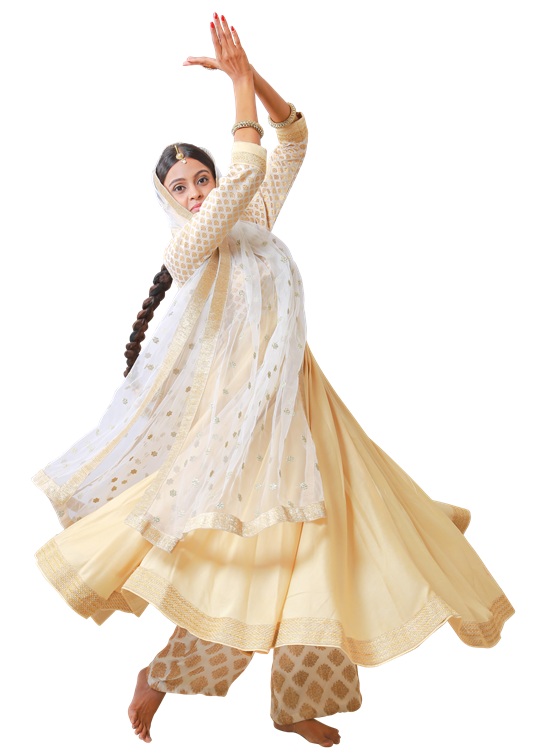
“The dance is the mother of the arts. Music and poetry exist in time; painting and architecture in space. But the dance lives at once in time and space.”
– Curt Sachs (German musicologist)
Any gesture in dance is a coming together of Gati (flow or movement) and Sthanaka (stillness), and rooted in the state of Sthiti (the un-manifest or Silent state) of the dancer. From this point, the process of creation of further movements begins, based on Laya (tempo) and Taal (rhythm) – the two crucial elements of music and dance.
All of life is this inter-play of stillness and dynamism. The stillness of a sap is manifested in the beauty of the trunk, the branches, leaves, flowers and fruits. So is the stillness of a dancer manifested in dance through various movements of the body and expressions of the face, with each transformation complete in itself and also coming together as a Whole.
The purpose of the practice of Indian classical dances has been the experience of this creation from the Self and of returning back into the Self, both for the dancer and the viewers.
Kathak, one of the eight of such classical dance styles of India, is a beautiful form full of graceful, fluidic movements and Bhaav – the experience and expression of a mood or an emotion. Various movements of the dance combine with Bhaav to create “Rasa”.
The concept of Rasa in Vedic arts
The word “Rasa” literally means “juice”, “taste” or “essence” and is found in various Vedic literature including the RKVeda, Atharvaveda and the Upanishads in different contexts and meanings. In Indian arts, Rasa is the aesthetic flavor, or the essence of any written, visual or aural work that creates an emotional feeling and elicits the desired response from the audience.
The Rasa theory for Indian arts and aesthetics is found in sage Bharata’s colossal work, the NatyaShastra (5th Century B.C), which predates Aristotle’s Poetics, and forms the basis of all Indian performing arts.
In its truest expression, any work of visual arts, whether dance, music or theatre, should be able to raise the level of consciousness of both the performer and the audience by making them travel within their own minds. The experience of “Rasa” is said to be the end objective of any visual or performing arts, and is usually associated with the feeling of “Ananda” or bliss. Rasa, therefore, can be seen as the source and the outcome of any creative work – a poetry, music, dance, painting or sculpture.
Though the origins of the Rasa theory is in Indian arts, its application over time has transcended disciplines and cultures and the concept has been applied to different philosophies and even in fields of psychology and neuroscience.
In Kathak, various Nritya or expressive pieces are performed, that evoke different emotions based on the nine Rasas.

Depiction of Shringara Rasa in Kathak dance
Kathak – the origins and history
Kathak has its origins in the NatyaShastra, an ancient text that serves as the foundation for all Indian performing arts. Derived from the Sanskrit word “Katha,” meaning story, Kathak was initially performed by travelling bards who narrated mythological tales through dance and mime, often as a form of temple offering.
Kathak came to be greatly influenced by the Bhakti movement in India around the 15th century. Themes of devotion to Lord Krishna (an incarnation of Lord Vishnu) and episodes from his life and times became central. Songs and poetry depicting the love of Krishna and his consort Radha written by many saint-poets began to be danced. Songs in praise of the Gods and Goddesses were also composed in regional languages and dialects with the intent of making the knowledge found in spiritual texts more relatable to a wider public and these messages of divine love and surrender were spread across the land.
In the medieval period, the Mughal influence moved Kathak from temples to royal courts, incorporating Persian elements into its music and aesthetics. Despite a decline during British rule, Kathak experienced a revival after India’s independence and continues to thrive today through three major styles or “Gharanas”—Lucknow, Jaipur, and Banaras—each with its own unique emphasis on expression, rhythm, and movement.


Dancing at the RangaMandap and at a NagaLingam in a temple
in Andhra Pradesh, India
Costume in Kathak
Each classical dance form can be identified through its costumes and get-up.
The costume worn in Kathak is usually a long flowing skirt called a lehenga / ghaghra or a long, flared top that end a little over the ankle called a kurta. The fluid fabric adds to the appeal of the dance especially with the spins or pirouettes. A long scarf, called dupatta is draped aesthetically over the attire. Ornaments such as earrings, bangles, and a maang-tikka on the forehead usually complete the look.


A lehenga (or ghagra) in Kathak
A kurta and dupatta
The aural experience in Kathak
Music is integral to Kathak, primarily using Hindustani classical styles like Thumri and Ghazal. Key instruments include the tabla, sarangi, sitar, flute, and harmonium. Ghungroos, the ankle bells, enhance the rhythm and hold deep spiritual significance. As the dancer creates sounds like Taa Thei Thei Tat, the vibrations connect with the earth, generating a transcendental energy.
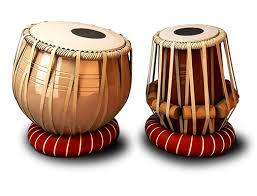
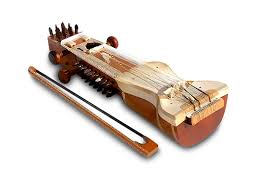
Tabla; the instrument of percussion in Kathak
Sarangi ; the instrument for melody

Tying Ghungroos before a Kathak performance
Raising consciousness with Kathak dance
Yajnasya phalam asnute
Sa sarvakaman apnoti Moksopayam cha vindati…
The offering of dance to the accompaniment of vocal and instrumental music assures the merit equivalent to a yagya… It not only fulfills all desires but assures Moksa (liberation) for the Sadhaka (the devotee)
– Vishnu Dharmottara 3, 34 26-29
Kathak is not merely a performing art; it is a spiritual practice that connects the dancer with higher consciousness.
For any seeker, a spiritual practice starts with the consecration of the tangible and intangible space. This may involve an elaborate arrangement with flowers, incense, fruits as offerings to the divine or a simple act of choosing a small space where one can be comfortably seated for their spiritual practice without any external disturbance. This can be followed by chanting or a silent prayer to one’s Guru (Master) and the divine.
Similarly, any practice of Kathak begins with a Bhoomi Pranam, an obeisance to the five elements of space, air, fire, water and earth that make up creation, and to the Guru. The dancer also performs a Ranga Mancha Puja, which is an offering to the stage, with the intent to invoke divine blessings and protection for the dancer as well as the audience that take this journey together.

A gesture from a Vandana;
an offering to the deities
The basic stance in Kathak dance is Samabhanga, Samapada and Samadamsa Mudra with the hands (also called Hamsasya in the text AbhinayaDarpan and Arala in another text called Sangitaratnakar). The word Sama means “to be in balance” or “in an equal position”. Therefore, the body is equally balanced between the right and left sides.
There is perfect symmetry in the way the feet, torso, hands and head are held. This stance creates a geometry of lines, triangles and circles and an energy-diagram, or a Mandala around the dancer. The body acts as a medium of the flow of spiritual energy through footwork, various movements of the Hastas (hands), body angles and Hasta Mudras.
The Hasta Mudra (gesture of the hand), is one where the forefinger touches the thumb and the hand is slightly curved. This Mudra is akin to the Jnan Mudra, and is used for focus, meditation or to denote transcendence. The hands holding this Mudra are kept at chest level. All hand movements in Kathak begin and end with this mudra.
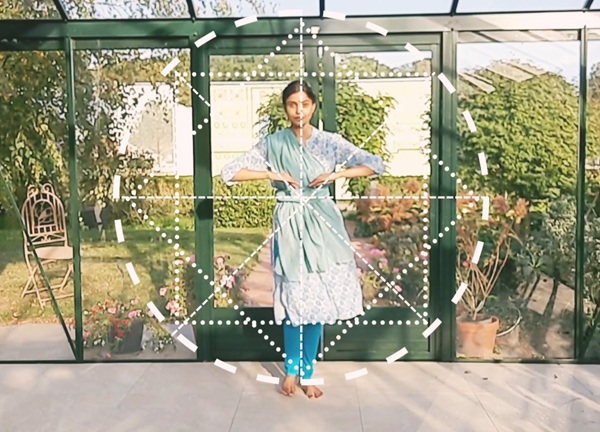
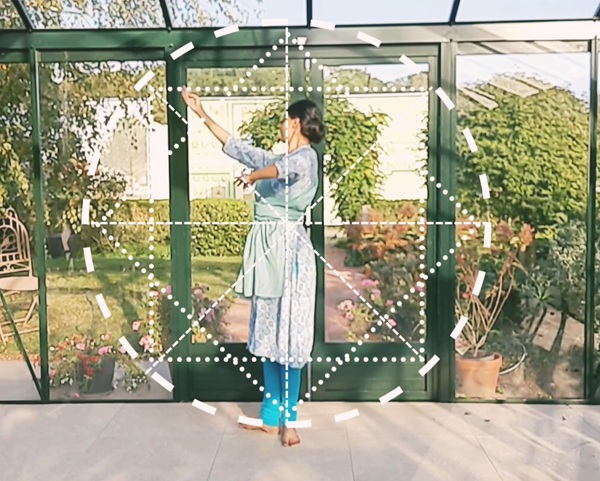
A graphic representation of a symmetrical Mandala in Kathak by the dancer
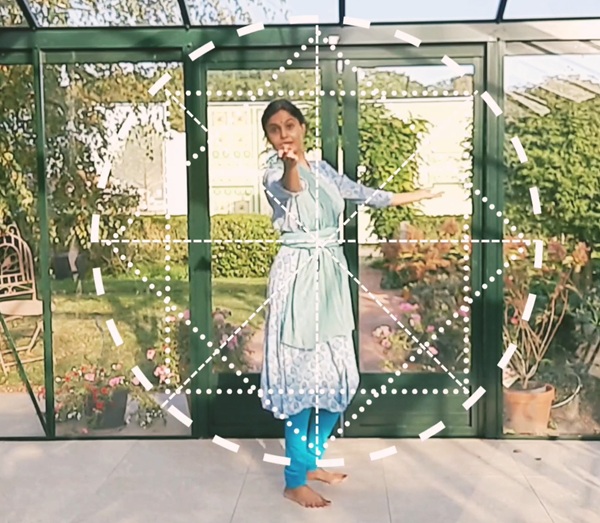
While there is enormous spiritual symbolism inherent in Kathak dance, including performing a Vandana or obeisance to the Guru and the Vedic Devata, which could be an offering to Lord Ganesha, Lord Vishnu or the Divine Mother to start a performance and narrating stories from Vedic texts and literature, by taking various postures of the Gods and deities and infusing them with Bhaav and Rasa, the dancer also incorporates those values in her / his being.
The constant connection of the bare feet with the earth while dancing various rhythmic patterns is by itself therapeutic. The movement of the head, neck, torso, hips, thighs and feet along the linear axis of the spinal cord and coordinated breathing de-stresses the body and releases blockages, thereby making the nervous system more conducive to higher spiritual experiences.
Kathak is seeped deeply in Bhakti and Yoga. More than a performing art, it is an inward journey for both the practitioner and viewer.
Conclusion
Kathak provides therapeutic benefits by harmonizing the body and mind. The movements align with the natural flow of energy, relieving stress and enhancing mental clarity. The repetitive patterns of footwork create a meditative rhythm that calms the nervous system, making Kathak a holistic practice that nurtures both physical and spiritual well-being.
In conclusion, Kathak is a profound dance form that transcends entertainment to become a medium of self-discovery and spiritual growth. As the poet Rumi said, “In order to understand the dance, one must be still. In order to truly understand stillness, one must dance.”


Yagyaa Srivastava is a Kathak dancer from India, recognized as a “Promising artiste” under the Government of India’s cultural initiatives. She has performed across India and internationally, including at the Embassy of India in Prague. Along with performing, she conducts workshops and lectures for diverse audiences. As a faculty member at Maharishi College of Perfect Health International, she integrates Indian classical dance with Transcendental Meditation, offering a holistic approach to wellness through Vedic Dance.
Discover the beauty of Kathak
To deepen your connection to movement, rhythm, and expression with Yagyaa Srivastava, join an upcoming workshop and experience the transformative power of this classical dance.
Find out more and register here:



